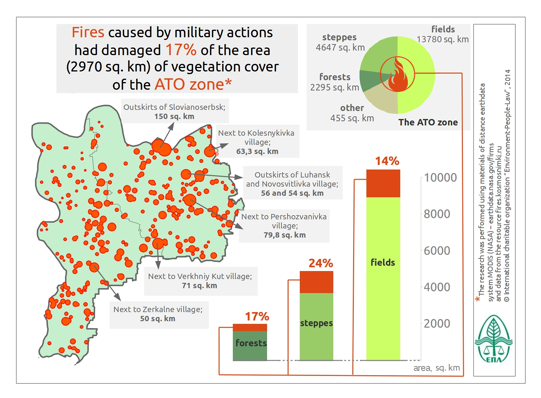The research conducted by experts of International charitable organization “Environment-People-Law” revealed that as a result of shelling of Shchastia town the concentrations of hazardous substances have considerably increased. Indicators for certain pollutants in the air have substantially exceeded maximum permissible concentrations.

The research was performed using the data of the Automatic Environmental Monitoring System for Luhansk region.2 The data used for the research come from the automatic monitoring point that until recently functioned in the town of Shchastia. The data on air composition were automatically registered by the point until it was destroyed by shelling.
“During shelling of Shchastia town starting from the third decade of July until the third decade of August there was considerable growth of concentrations of sulphur dioxide, nitrogen dioxide and carbon dioxide”, comments environmentalist of “Environment-People-Law Kateryna Norenko. – Moreover, concentrations of sulphur dioxide and nitrogen considerably exceeded maximum permissible concentrations (MPC). On 13 August, the concentration of sulphur dioxide exceeded MPC by 5 times, on 14 August – by 8 times.
Environmentalists believe that the growth of concentrations of hazardous oxides is related to shelling of the town. It was before September 17 when artillery shelling of Shchastia town and its outskirts took place.3 It is important to emphasize that the dynamics of concentrations of the above mentioned substances in the air is not related to operation or nonoperation of Luhansk thermal power plant located in Shchastia town. The power plant operated uninterruptedly until August 17 when a shell hit the transformer and stopped both the operation of the power plant and the Automated Monitoring System that stopped registering data because of power cut-off.4
“Increased concentrations of sulphur dioxide, carbon dioxide and nitrogen in the air definitely pose a threat for human health. Moreover, these substances are hazardous for pine plantations that surround the town”, adds the executive director of International charitable organization “Environment-People-Law” Olena Kravchenko.
EPL experts believe that when calculating damage the country endured because of the military actions, it is necessary to take into account amounts of used explosive substances that caused air pollution and deterioration of human health.
Contac details:
Kateryna Norenko
Environmentalist of International charitable organization “Environment-People-Law”
Email: office@epl.org.ua; kateryna.norenko@gmail.com
tel.: (032) 225 – 76 – 82; 097 352 8485
Reference information
In the course of explosion all substances used in the explosive undergo full oxygenation and by-products of the chemical reaction are released into the air, the main of them are carbon dioxide and water vapor that are not toxic and are harmful only in the context of global climate change because they both are greenhouse gases. However, 1 kg of explosive creates several dozens of cubic meters of toxic gases: SO2, NOx, CO that also contain hazardous underoxygenated organic compounds including aromatic substances that are much more toxic than usual ones.
In the air sulphur dioxide produces sulfurous anhydride that causes acid rains that change pH of soil and cause plant burnings. Nitrogen dioxide also causes acid rains.
The most resistant to high concentration of sulfurous gas (SO2) in the air are oak and birch and the most sensitive are pine and fir-tree.
Impact on human health. Acid rains worsen respiratory diseases that invisibly depress human health. Sulfur dioxide causes intensified mucus release in respiratory system, cough, “frog-in-the-throat”, throat discomfort, pain in the eyes. Even small amounts of carbon monoxide (CO) cause dizziness and nausea. CO together with hemoglobin creates a comparatively stable compound – carboxyhemoglobin that deprives blood of the ability to transport oxygen to tissues of organism.
Nitrogen oxides cause irritation of mucous membrane. Moreover, small concentrations (4 promille) can cause retention of breath. Nitrogen dioxide causes changes in blood composition, in particular it decreases hemoglobin level. Nitrogen dioxide causes decreased resistance of human organism to diseases, oxygen hunger of tissues, especially with children. This gas causes impairment of smell sense and nocturnal eyesight. Negative impact on eyesight starts with the concentration of 0.14 mg/m3. Difficulties with breathing start with the concentration of 0.056 mg/m3. Inhaling of vapor of aromatic carbon oxides causes the impact similar to drugs, then come depression, convulsions, retention of breath. Also, the impact is characterized by harm to blood system and blood producing organs, liver, endocrine system and by nervous system disorders. Vapor and dust of aromatic carbon oxides cause crystalline lens opacity.

